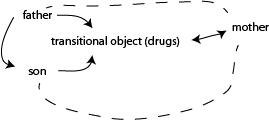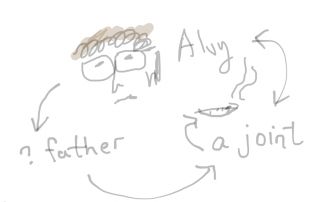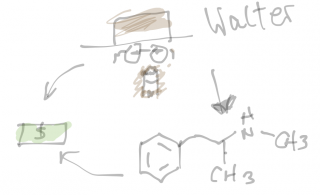Alcoholism
American Masculinity and Drugs
Changing relationship between men and their transitional object
Posted August 25, 2015

I visited Hemingway's old house a few years ago. I remember parking a tiny white Smart Car amidst the noisy crowd of Key West, walking past the slow, meditative garden that now doubles as a wedding venue, and arriving at the leafy femininity of the front porch: a place of jarring misalignment of a man and his cats in a world of imagination of a larger than life, uncompromisingly male stream-of-consciousness. A world of hard edged, dirty, catastrophic maleness, and a world of alcohol. Hemingway represents that early 20th century maleness that links alcohol with adventure, the aching admiring doting eyes of a child on his father in telling and retelling of the stories of blood, war, and sexual conquest. Like Fitzgerald, Hemingway's alcohol represents a fragile exterior of meaning and potency -- a weapon to lose that potency in service of a more worthwhile plot device -- like the end of The Sun Also Rises -- the maternal death, the ultimate castration fantasy. Alcohol is a blade. To brandish it implies that you believe you have something prominent to cut.

The structure of the Homeric Winnicott triad (Fig. 1) between father - son and the transitional object (drugs) has not been on my mind until recently, when by chance my curiosity with the Spanish civil war was rekindled. It is a moving, glandular structure in time. War is the father, and canonical heroics of early 20th century American men marching to Europe, a Freudian struggle. Alcohol was perfect, surgical - warm yet persistently and obviously harmful, addictive in its masochistic inevitability.

Alvy doesn't know how to do drugs right, and we thank him for it.
Toward mid century, alcohol migrated to cannabis, and the center of the world migrated from Paris to New York. The libidinal dominance in sex migrated to outright obsession. Men came out of the trenches and onto the couch. The iconic musing of Portnoy redefined the American male psyche in its fully glorious, masturbatory interiority. The most appealing quality of Alvy Singer is his neurotic refusal to take that intoxicating hit after making love, and this refusal, and its occasional misanthropic slip, represent a game changing, phase transitioning moment in a long march of the extraordinary, brewing influence of Jewish diaspora on American culture: that Harvard no longer only takes "athletic" old money, that a Catholic can become the president, that men can go to the moon.
This insatiable, rebellious, originally eccentric but rapidly metabolized and universalized indulgence of cannabis, and its associated hallucinatory pathos of post-war maleness reached its apogee, and gradually disintegrated hereonafter, in the 80s and 90s. Best eulogy I can think of was The Big Lebowski. Watching it after the second Bush highlights its lugubrious essence: women define both the meaning and the semiotics of everyday life; men and their drug addled Bildungsroman, their tedium and stasis, however aggressive, just a sideshow. Marijuana is not a blade. It has none of the sharp edges of alcohol. It is more like a silk harness that pulls you away from the triad, strangles you with its smooth, maternal lethality.
We are left to piece together American masculinity, and its relationship to drugs, of today: no longer one ideal, but a fragmented, heterogeneous, inflationary complexity. We have characters that are truly Asiatic and foreign, and abstinent, yet undisputedly American, like Bruce Lee and Oscar Wao. The castration here is complete and insouciant, and our goal is not to inflict further damage but to figure out how to "grow a pair". We have teetotaler heartland anomies, like the lonely, pasty Jimmy Corrigan, the Smartest Kid on Earth, that remind us that the outsider status is not always a result of ethnic ostracism. Drugs are a red line that pushes the inner circle far away from the outer circle, a crude metric of the gradually diminishing role of bros in the closure of American mind.

Walter doesn't use drugs. He only sells them.
It's not surprising that the ideal medium for the post-postmodern patrilineal voice, like the texts of the gilded ages and the films of the flower power, is television. Walter White tries to take back the role of the father, and inflict damage, and stop the cycle of unsuccessful placating of social mores (father). Crystal meth is a gun...or some other projectile weapon simile that I cannot identify. It is outwardly deadly, yet also synthetic, manufactured, plastic: its high short-lived and precipitously non-narrative. It is a drug of choice of a certain transcendental narcissism that came to represent the reality of masculinity in the early 21st century: the faking the need to be fake Brooklyn hipster maleness that became the untethered cultural currency. Walter's fatherly desire has nothing to do with responsibility, which is precious, if porous. It is an unsettling reassertion of self in an increasingly loosy-goosy world of confusing identities. He sells drugs but doesn't use them. To him, drugs are a metaphor for disappointments, for loss, for a weakness and a disease. Selling is to let go. He tries and fails. The humming train of a century of disintegration of unitary maleness has left him tragically behind. The ideal male of today is one of deliberate and multifaceted vulnerability and indecision, of Jesse, of quiet, androgynous suffering and inebriation, and it is totally okay.
The transitional object has to go, and we are left with finding new meaning, and answers to other big questions, elsewhere. New resolution: read more female authors and watch more movies that pass the Bechdel test.


